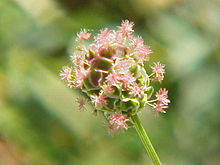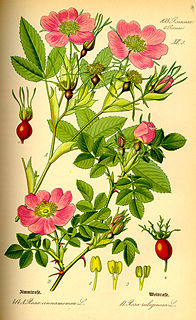
Rosales is an order of flowering plants. It is sister to a clade consisting of Fagales and Cucurbitales. It contains about 7,700 species, distributed into about 260 genera. Rosales comprise nine families, the type family being the rose family, Rosaceae. The largest of these families are Rosaceae (90/2500) and Urticaceae (54/2600). The order Rosales is divided into three clades that have never been assigned a taxonomic rank. The basal clade consists of the family Rosaceae; another clade consists of four families, including Rhamnaceae; and the third clade consists of the four urticalean families.

Rosaceae, the rose family, is a medium-sized family of flowering plants, including 4,828 known species in 91 genera.

Amygdaloideae is a subfamily within the flowering plant family Rosaceae. It was formerly considered by some authors to be separate from Rosaceae, and the family names Prunaceae and Amygdalaceae have been used. Reanalysis from 2007 has shown that the previous definition of subfamily Spiraeoideae was paraphyletic. To solve this problem, a larger subfamily was defined that includes the former Amygdaloideae, Spiraeoideae, and Maloideae. This subfamily, however, is to be called Amygdaloideae rather than Spiraeoideae under the International Code of Nomenclature for algae, fungi, and plants as updated in 2011.
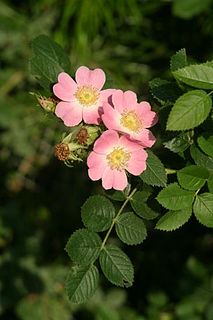
The rose subfamily Rosoideae consists of more than 850 species, including many shrubs, perennial herbs, and fruit plants such as strawberries and brambles. Only a few are annual herbs.

Prunus is a genus of trees and shrubs, which includes the fruits plums, cherries, peaches, nectarines, apricots, and almonds.

Dryas is a genus of perennial cushion-forming evergreen dwarf shrubs in the family Rosaceae, native to the arctic and alpine regions of Europe, Asia and North America. The genus is named after the dryads, the tree nymphs of ancient Greek mythology. The classification of Dryas within the Rosaceae has been unclear. The genus was formerly placed in the subfamily Rosoideae, but is now placed in subfamily Dryadoideae.

Aphanes (parsley-piert) is a genus of around 20 species in the rose family (Rosaceae), native to Europe, Asia and Australia. A 2003 study indicated that Aphanes may belong to the genus Alchemilla, commonly called lady's-mantle. They are slender, annual prostrate herbs, much-branched with deeply lobed leaves, pilose and on short petioles. The tiny green to yellow flowers without petals grow in clusters in the denticulate leaflike stipules.

Cercocarpus, commonly known as mountain mahogany, is a small genus of at least nine species of nitrogen-fixing flowering plants in the rose family, Rosaceae. They are native to the western United States and northern Mexico, where they grow in chaparral and semidesert habitats and climates, often at high altitudes. Several are found in the California chaparral and woodlands ecoregion.

Dasiphora is a genus of three species of shrubs in the rose family Rosaceae, native to Asia, with one species D. fruticosa, ranging across the entire cool temperate Northern Hemisphere. In the past, the genus was normally included in Potentilla as Potentilla sect. Rhopalostylae, but genetic evidence has shown it to be distinct.

Duchesnea indica, known commonly by the names mock strawberry, Indian strawberry, or false strawberry, is a flowering plant in the family Rosaceae. It has foliage and an aggregate accessory fruit similar to that of a true strawberry. It has yellow flowers, unlike the white or slightly pink flowers of true strawberries. It is native to eastern and southern Asia, but has been introduced to many other areas as a medicinal and an ornamental plant. It has been naturalized in many regions, including parts of the United States.

Purshia is a small genus of 5-8 species of flowering plants in the family Rosaceae, native to western North America, where they grow in dry climates from southeast British Columbia in Canada south throughout the western United States to northern Mexico. The classification of Purshia within the Rosaceae has been unclear. The genus was originally placed in the subfamily Rosoideae, but is now placed in subfamily Dryadoideae.
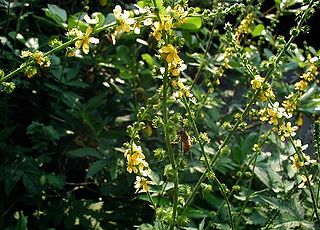
Agrimoniinae is a subtribe of the rose family, Rosaceae. It is the sister to subtribe Sanguisorbinae in tribe Sanguisorbeae. It includes the Afromontane endemics Hagenia and Leucosidea.

Sanguisorbinae is a subtribe of flowering plants in the rose family, Rosaceae. It is the sister to subtribe Agrimoniinae in tribe Sanguisorbeae.

Vauquelinia, commonly known as the rosewoods, is a genus of the rose family, Rosaceae. It consists of two species of shrubs found in the southwestern United States and northwestern Mexico. The genus was named for French chemist Louis Nicolas Vauquelin (1763-1829). The nectar provided by these plants is commonly fed on by wasps such as Polistes instabilis.

Kageneckia is a genus of flowering plant in family Rosaceae.

Comarum is a genus of plants formerly included with the genus Potentilla. It contains one or two species:
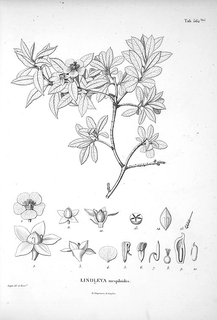
Lindleya is a genus of Mexican evergreen trees of the family Rosaceae. The sole species, L. mespiloides, grows to a height of 6 metres (20 ft) and bears solitary white fragrant flowers in summer. The fruit are dry dehiscent capsules.

Drymocallis is a genus of plants formerly included with the typical cinquefoils (Potentilla). It contains three species known or suspected to be protocarnivorous, but more cinquefoils might eventually be moved here:

The Maleae are the apple tribe in the rose family, Rosaceae. The group includes a number of plants bearing commercially important fruits, such as apples and pears, while others are cultivated as ornamentals. Older taxonomies separated some of this group as tribe Crataegeae, as the Cydonia group, or some genera were placed in family Quillajaceae.
Sorbus leighensis, the Leigh Woods whitebeam, is a rare species of whitebeam, a flowering plant in the rose family.
